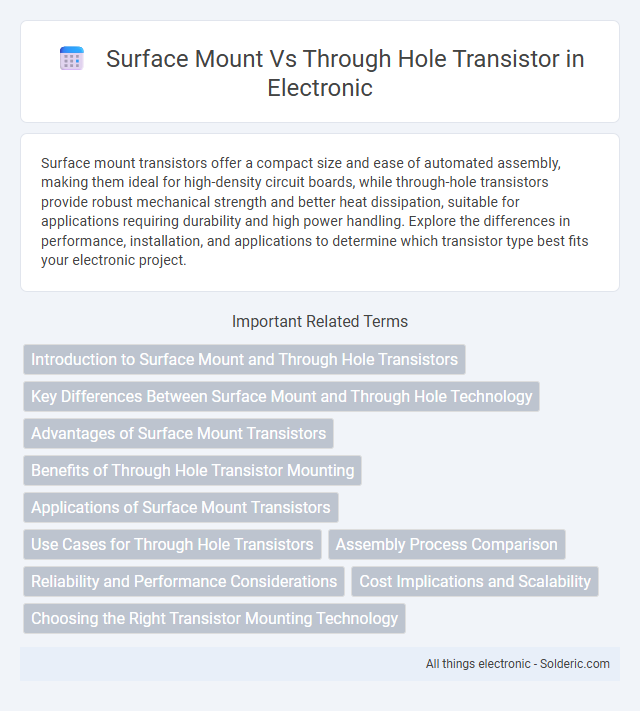Surface mount transistors offer a compact size and ease of automated assembly, making them ideal for high-density circuit boards, while through-hole transistors provide robust mechanical strength and better heat dissipation, suitable for applications requiring durability and high power handling. Explore the differences in performance, installation, and applications to determine which transistor type best fits your electronic project.
Comparison Table
| Feature | Surface Mount Transistor (SMT) | Through Hole Transistor (THT) |
|---|---|---|
| Mounting Technique | Soldered directly onto PCB surface pads | Leads inserted through PCB holes and soldered |
| Size | Compact, smaller footprint | Larger size due to leads and body |
| Assembly | Suitable for automated pick-and-place assembly | Requires manual or wave soldering |
| Electrical Performance | Lower parasitic inductance and capacitance | Higher parasitic effects due to lead length |
| Mechanical Strength | Less mechanical stress tolerance | Better mechanical stability and durability |
| Repair and Prototyping | More difficult to rework and replace | Easier to handle for testing and repairs |
| Applications | High-density, compact electronic designs | Power electronics, rugged environments |
Introduction to Surface Mount and Through Hole Transistors
Surface mount transistors are designed for compact, automated assembly on printed circuit boards (PCBs) and offer reduced parasitic inductance compared to through hole transistors, which require leads to pass through PCB holes for soldering. Through hole transistors provide stronger mechanical bonds and better heat dissipation, making them ideal for high-power applications and prototyping. Understanding the mounting technology impacts circuit design, reliability, and manufacturing costs, influencing the choice between surface mount and through hole transistors.
Key Differences Between Surface Mount and Through Hole Technology
Surface mount transistors are smaller, allowing for higher component density and improved performance in compact circuits, while through hole transistors offer stronger mechanical bonds ideal for high-stress or high-power applications. Surface mount devices are soldered directly onto the surface of the PCB, enabling automated assembly and faster production, whereas through hole components require leads to pass through drilled holes, providing more secure connections. Choosing between surface mount and through hole transistors depends on your design requirements, balancing size, durability, and manufacturing complexity.
Advantages of Surface Mount Transistors
Surface mount transistors offer significant advantages such as smaller size, which enables high-density circuit designs and improved performance in compact electronic devices. Their reduced lead inductance enhances high-frequency operation, making them ideal for RF applications. Automated assembly processes for surface mount transistors also increase manufacturing efficiency and reduce production costs compared to through-hole counterparts.
Benefits of Through Hole Transistor Mounting
Through hole transistor mounting offers superior mechanical strength and durability, making it ideal for applications subjected to high stress or vibration. Its leads provide reliable electrical connectivity and easy prototyping on breadboards and perfboards, enhancing troubleshooting and component replacement. You benefit from its compatibility with higher power devices and improved heat dissipation compared to surface mount alternatives.
Applications of Surface Mount Transistors
Surface mount transistors are widely used in compact electronic devices such as smartphones, tablets, and wearable technology due to their small size and efficient heat dissipation. Their design supports high-density circuit boards, making them ideal for automotive electronics, consumer gadgets, and medical equipment. Your choice of surface mount transistors can enhance device performance while reducing manufacturing costs and assembly time.
Use Cases for Through Hole Transistors
Through hole transistors are commonly used in applications requiring high power dissipation and mechanical stability, such as power amplifiers and industrial equipment. Their robust mounting provides better heat dissipation and durability, making them ideal for prototypes and circuits exposed to mechanical stress. You will often find through hole transistors in automotive systems, audio amplifiers, and high-reliability electronics.
Assembly Process Comparison
Surface mount transistors are mounted directly onto the PCB pads using automated pick-and-place machines, enabling faster and more efficient assembly with reduced labor costs. Through hole transistors require manual or wave soldering after inserting component leads into drilled holes, which increases assembly time and complexity. The surface mount process supports higher component density and improved electrical performance due to shorter lead lengths compared to through hole assembly.
Reliability and Performance Considerations
Surface mount transistors offer higher reliability in high-frequency applications due to reduced parasitic inductance and capacitance, enhancing overall circuit performance. Through hole transistors provide better mechanical strength and heat dissipation, making them suitable for high-power, high-stress environments. Your choice between these options should depend on the specific reliability and performance demands of your project's operating conditions.
Cost Implications and Scalability
Surface mount transistors offer lower manufacturing costs due to automated assembly and reduced material usage, enhancing scalability for high-volume production. Through hole transistors require more manual labor and larger board space, increasing costs and limiting scalability in mass production environments. Cost efficiency and scalability favor surface mount technology in modern electronics manufacturing.
Choosing the Right Transistor Mounting Technology
Surface mount transistors offer compact size and enhanced performance for high-frequency applications, while through hole transistors provide superior mechanical strength and ease of prototyping. Selecting the right transistor mounting technology depends on factors like board space constraints, thermal management requirements, and automated assembly capabilities. Consider application-specific demands such as signal integrity, frequency range, and production volume to optimize reliability and manufacturing efficiency.
Surface mount vs Through hole transistor Infographic

 solderic.com
solderic.com